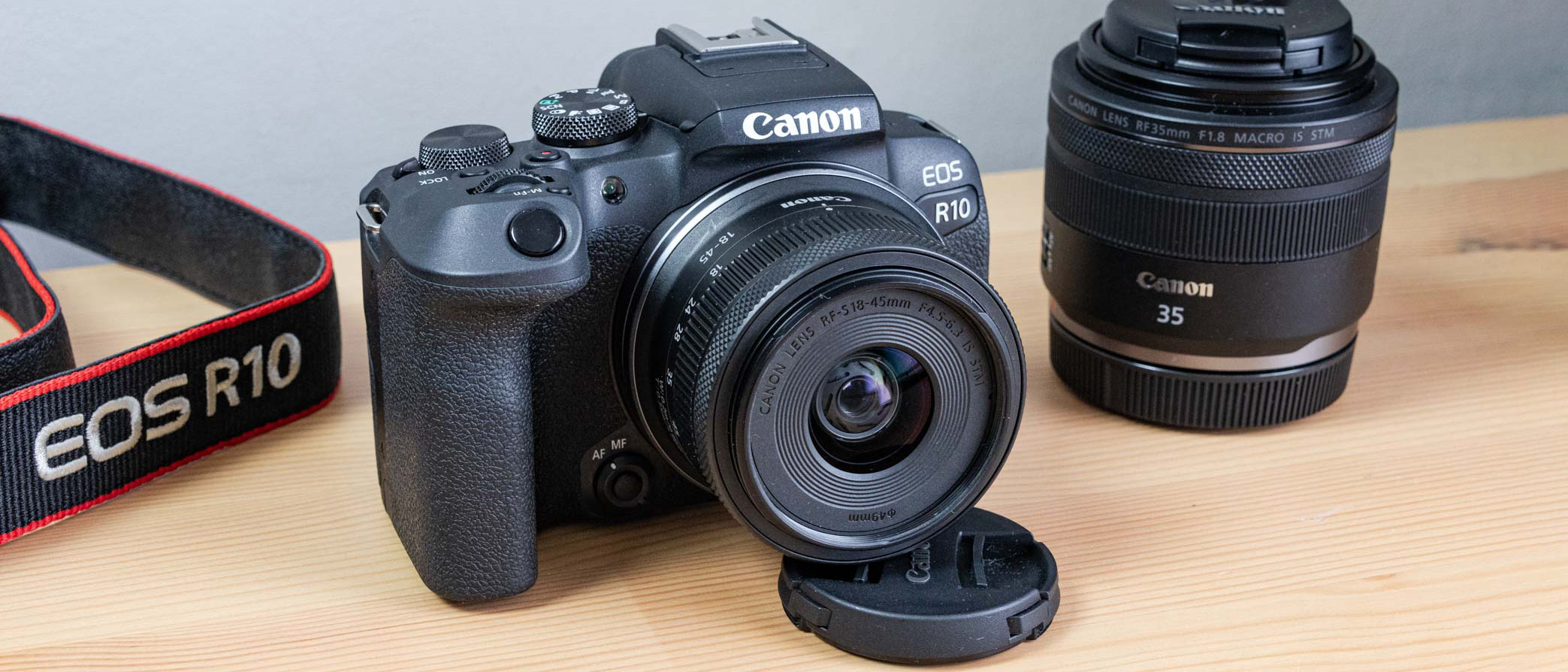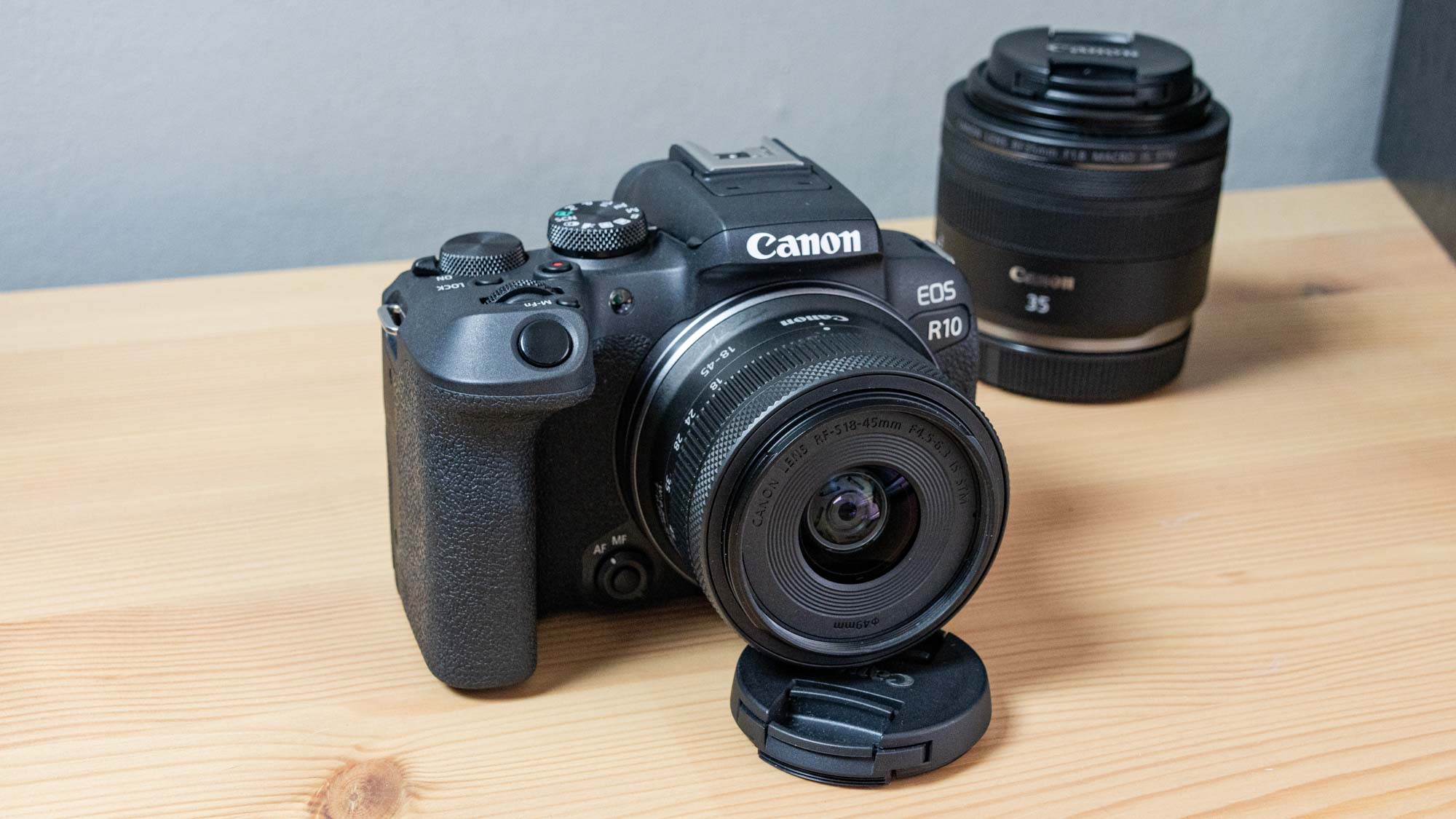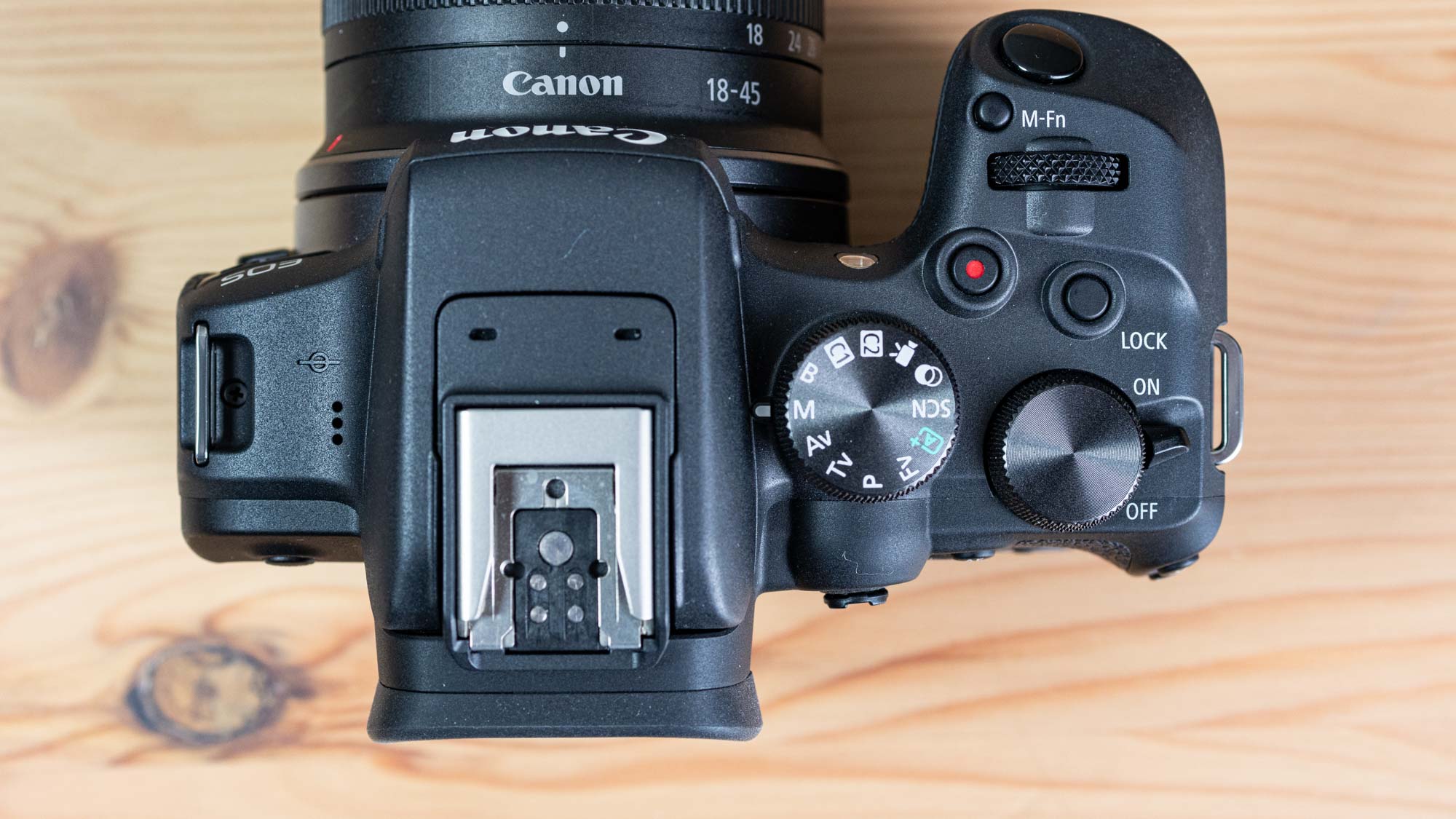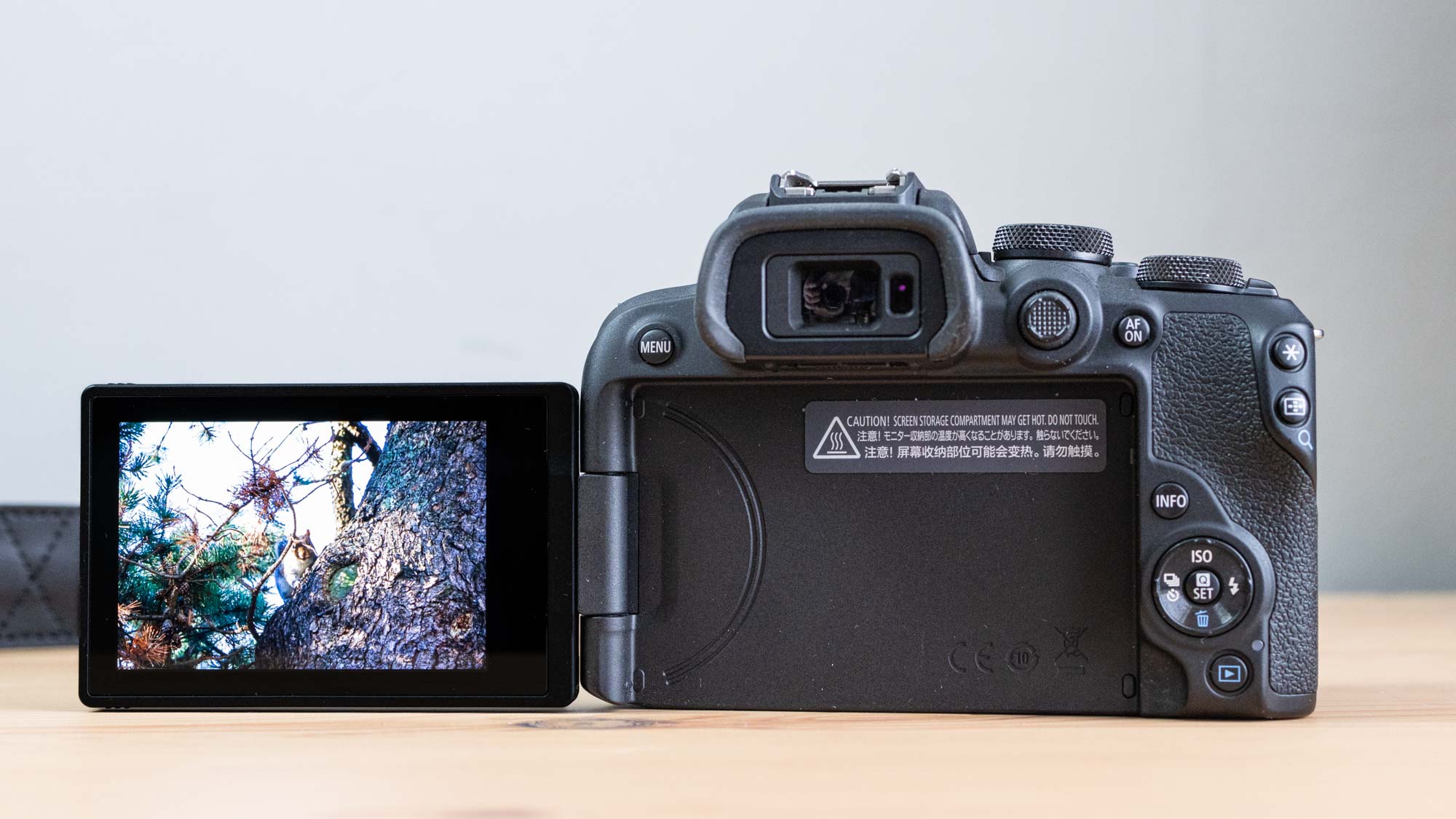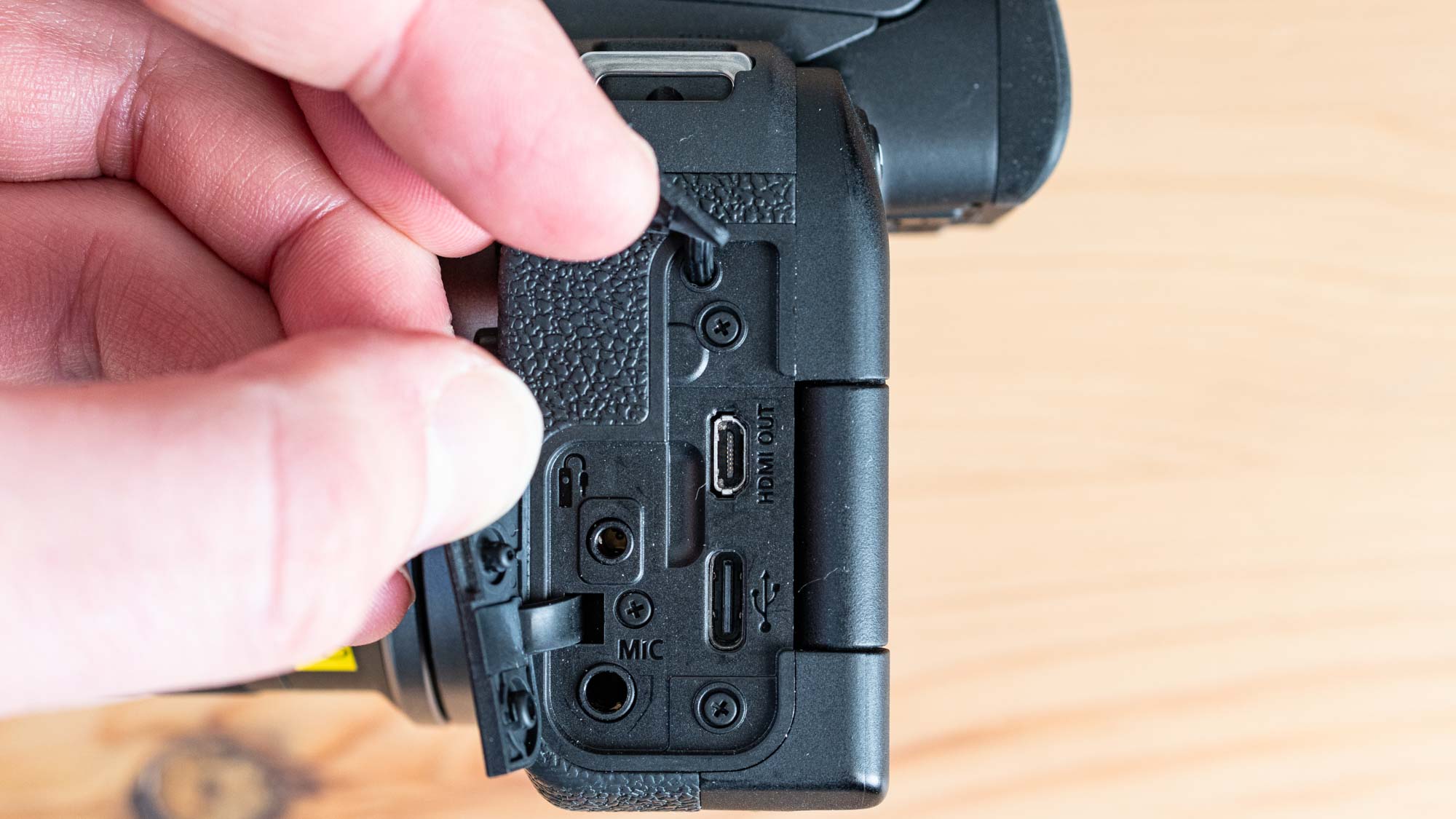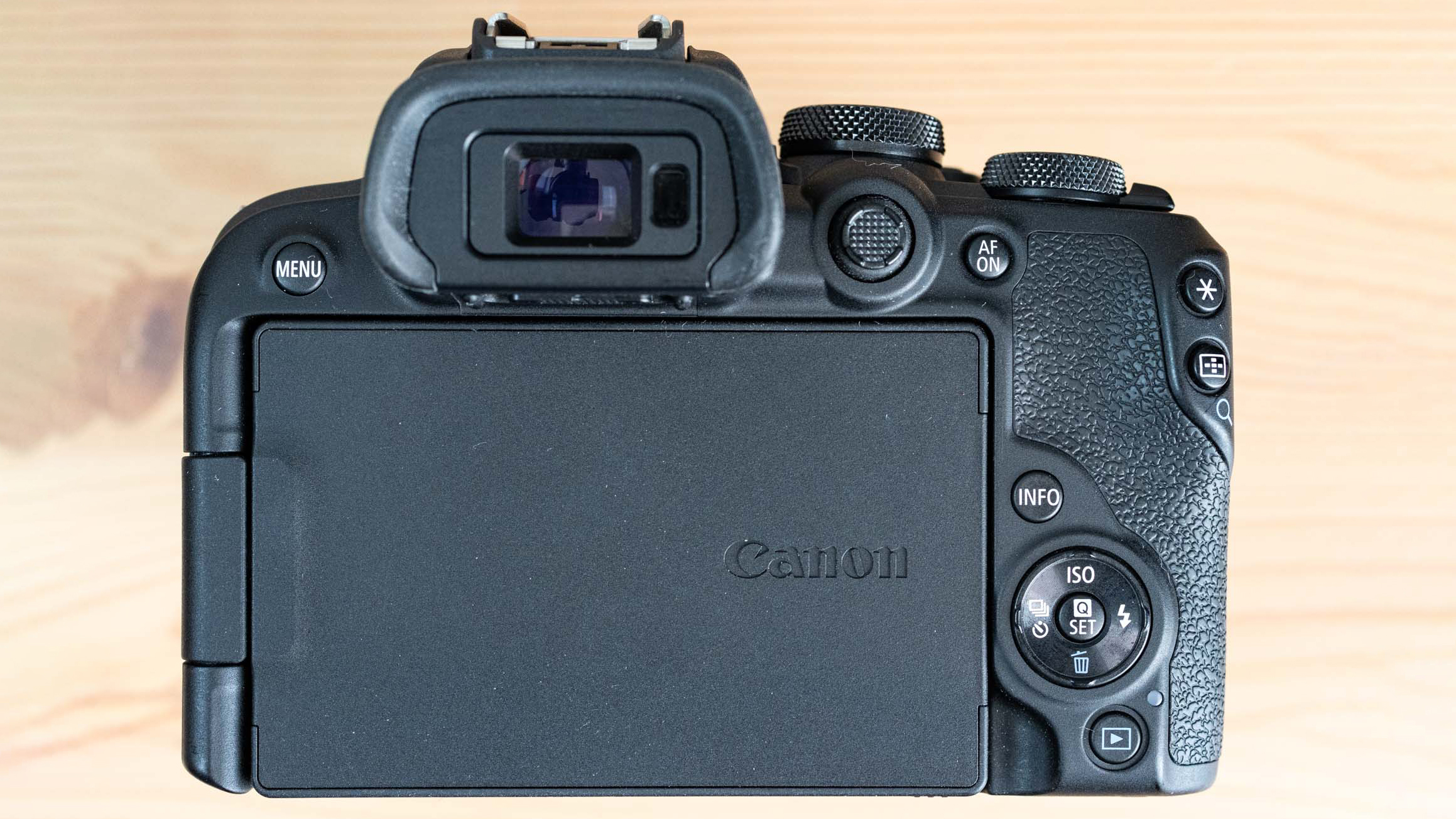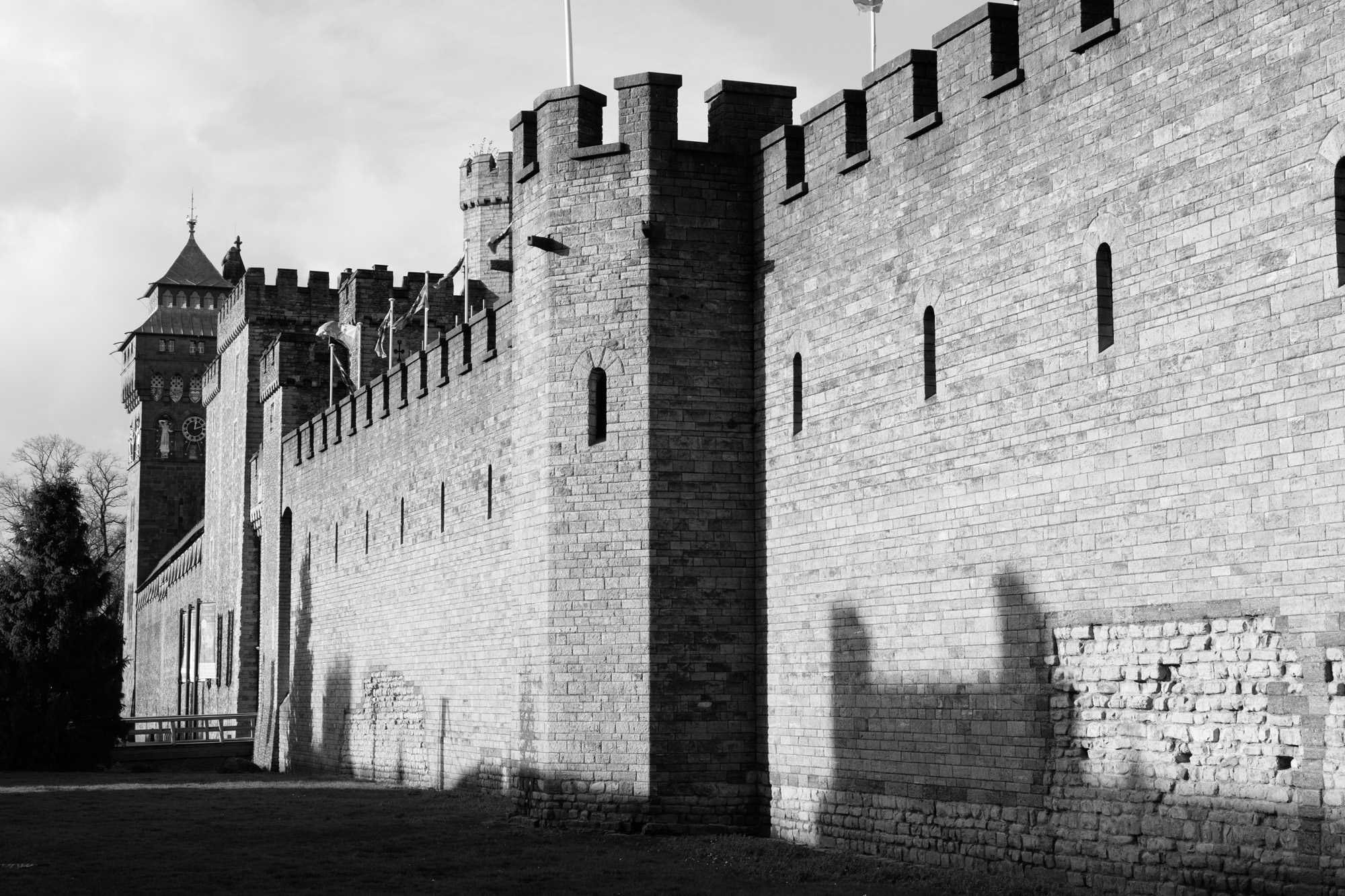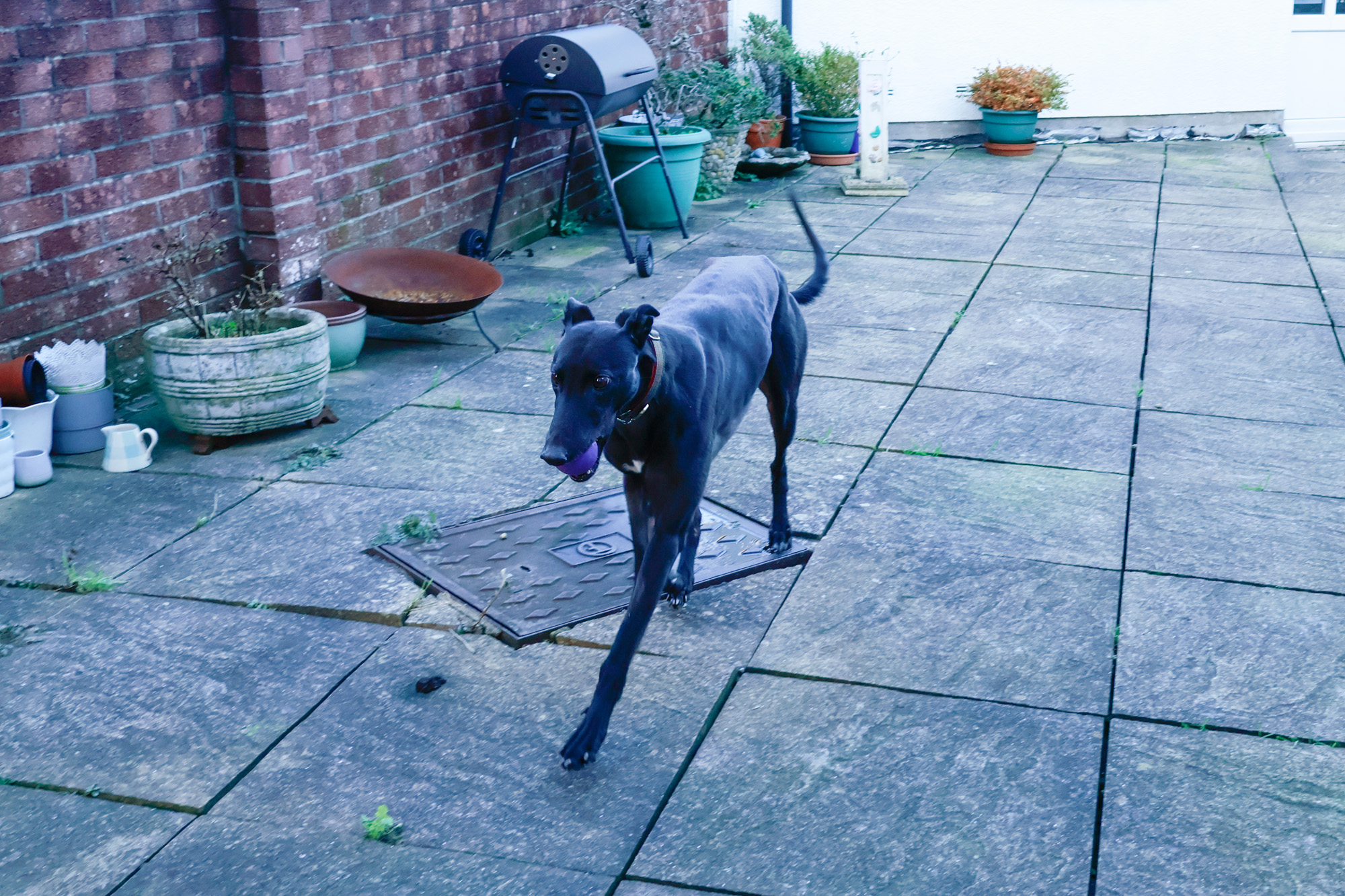Tom's Guide Verdict
The Canon EOS R10 is designed for hybrid content creators stepping up from a smartphone. It packs professional-grade autofocus, strong image quality and 4K/60p video into a very small body. Unfortunately, Canon’s RF-S lens lineup is currently very small, leaving few native lens choices, and the R10 does not feature in-body image stabilization (IBIS) or Canon Log, both limiting its long term potential.
Pros
- +
Great autofocus
- +
Lightweight design
- +
Shoots 4K at 60p
- +
High quality stills
Cons
- -
Lack of native RF-S lenses
- -
Feels a little cheap for price
- -
Rivals better suited to video
- -
Only outputs MP4 video
Why you can trust Tom's Guide
Sensor: 24.2MP APS-C Dual Pixel CMOS AF II
Image processor: DIGIC X
In-body image stabilization: No
AF points: 4,503-point
Viewfinder: 0.39-inch OLED EVF, 2.36 million dots
Display: 3.0-inch Vari-angle colour LCD Touch Screen, 1.04 million dots
ISO: 100-32,000 (expandable to 51,200)
Max video resolution: 4K at 60p (cropped)
Ports: USB type-C, micro HDMI, mic mini jack, headphone mini jack, hot shoe, E3 remote control
Storage: 1x SD/SDHC/SDXC UHS-II
Wireless: Wi-Fi 2.4GHz, Bluetooth 4.2
Shooting speed: 15fps mechanical, 23fps electronic
Battery life (CIPA): 430 shots
Size: 4.82 x 3.45 x 3.28 inchesWeight (body inc battery, card):; 15 ounces
The Canon EOS R10 is designed for enthusiasts wanting a lightweight camera for both high-quality photo and video content, and sits at the lower end of the mid-range category. Canon hopes its headline credentials (namely 4K/60p video) and lightweight APS-C design will coax smartphone or DSLR users into their first mirrorless purchase. This APS-C mirrorless camera is the little sibling of the Canon EOS R7 and a step up from the EOS R50, Canon’s entry point into the R-System mirrorless lineup.
The EOS R10 is great for street and travel shooting, as well as casual and family photography. For aspiring video content creators looking to boost the quality of their video, the R10 may well be a logical step up from one of the best camera phones or an entry-level camera. We think the R10 is definitely worthy of a spot on our best mirrorless cameras list. However, there are a few things we think you should consider before you buy this camera. Read on to see our full Canon EOS R10 review, and find out more.
Canon EOS R10 review: Price and availability
The Canon EOS R10 went on sale in mid-2022 and is priced at $979 / £899 in body-only format. In kit form, it can be purchased with the RF-S 18-45mm F4.5-6.3 IS STM Lens ($1,099 / £999) or the RF-S 18-150mm F3.5-6.3 IS STM Lens ($1,379 / £1,249). I tested the EOS R10 with both of these kit lenses, and herein lies this camera’s first problem.
RF-S lenses are Canon’s native lenses for APS-C R-System cameras, and right now, the only choice you have is from the two above, plus a third RF-S 55-210mm F5-7.1 IS STM. The EOS R10, EOS R7 and EOS R50 have all been out for a while now, so it’s a little surprising that there are still no APS-C native primes or faster zooms available.
It should be said that the kit lenses aren’t awful — they’re reasonably sharp, offer versatile zoom ranges for their intended uses, and will work well for video thanks to optical IS and little focus breathing. As you’d expect from Canon kit lenses though, they feel lightweight and cheap, and feature painfully slow maximum apertures. The latter hampers their effectiveness in low light, especially when using them at longer focal lengths for portraiture or wildlife photography.
You can use Canon’s EF and EF-S lenses via a mount adapter, where you’ll lose the benefit of the faster-focusing RF mount. Or, you can use Canon’s full frame RF lenses, as long as you remember to multiply every focal length you’re interested in by 1.6 to get an idea of the field of view you’ll wind up with thanks to the APS-C crop factor. I did just that, testing these cameras with the RF 35mm F1.8 MACRO IS STM — a brilliant full-frame prime lens with an equivalent focal length of around 56mm on APS-C, which is great for street and portraiture photography. The wide range of RF lenses means that a lack of RF-S lenses isn’t exactly a death knell for this camera, but more native lenses to choose from soon would be better.
Canon EOS R10 review: Design
The Canon EOS R10 stays true to Canon’s mirrorless R-System design language, which takes the old bulbous DSLR design philosophy and streamlines it a little to fit the mirrorless age. If you’re into Canons, you’ll love it, while if you’re into R-System cameras, you’ll love it even more, as this one looks exactly like all the rest of them. If you value functionality over form, you won’t care anyway. But if you’d like something a little prettier on a similar budget, you could try the Fujifilm X-T30 II instead.
Get instant access to breaking news, the hottest reviews, great deals and helpful tips.
Weighing in at 13.5 ounces (382g) and measuring approximately 4.8 by 3.4 by 3.2 inches (12 x 9 x 8cm), the EOS R10 is both lightweight and compact, although far from pocket-sized thanks primarily to its raised EVF housing and grip. That said, it fits into even the smallest of kit bags or backpacks without issue, won’t cause any grief around your neck during long days shooting and is easy to use at odd angles.
The lightweight design stems from the lack of in-body image stabilization (IBIS) and widespread use of plastic in the camera’s construction. While this may save some weight, it ends up making the body feel insubstantial, hollow and cheap — especially around the grip. That’s fine on an entry-level, sub-$500 DSLR like the EOS Rebel T100 (EOS 4000D), but this camera costs over $1,000, so I would’ve liked to see higher quality materials throughout, as you’d get with a Fuji or a Sony. Controls all feel premium, though: dials all clunk when rotated, while buttons are either damped for silence or click back nicely when pressed. The flash pop-up feels a little flimsy, but clicks back into place with purpose.
The EOS R10’s vari-angle touch screen is an immediate giveaway that it’s aimed at video content creators. Having the flip-out screen is ideal when shooting video to camera, and occasionally comes in handy when shooting photos in weird positions, too.
Unfortunately, at only 1.04M dots, the screen does a lackluster job at conveying focus, although it is nice and bright. The EVF is again not the sharpest, but at 2.36M dots is acceptable for day-to-day usage and checking focus.
In terms of ports, the EOS R10 offers one each of micro-HDMI, USB-C, 2.5mm audio jack and 3.5mm microphone jack. It only features a single card slot, which supports SD/SDHC/SDXC and UHS-II. While UHS-II support is good to see, especially for 4K video, the single card can become problematic, as we’ll see a little later on.
Canon EOS R10 review: Controls
The Canon EOS R10s controls are, for the most part, laid out extremely well and very easy to use. Buttons and dials are mostly all within easy reach during usage, allowing for fast paced shooting. I’m not a particular fan of the focus control pad placement, though, which sits close to the EVF housing and can be difficult to use fully when shooting through the viewfinder.
One feature I wish worked better is the EVF’s dioptric adjustment mechanism, which uses a slider rather than the customary dial found on most cameras. Unlike a dial, a slider allows you to see where you’re setting your dioptric adjustment. If you’re like me and wear glasses half the time, the slider helps you remember precisely where you need to set the adjustment for glasses or without — very handy when switching between the two! Unfortunately, placing the adjustment slider under the EVF is a bad choice, as it makes it incredibly difficult to adjust the slider while looking through the EVF (which you need to do in order to, y’know, work out where to put it).
I enjoyed using the responsive touchscreen and the well-laid-out menu that Canon and its users so regularly champion. As someone who shot on both a Sony A7 and Sony A7 III, I’m familiar with complicated menu systems, and appreciate the Canon menu’s simplicity. However, I found it annoying that I couldn’t flick between top sections (i.e. Camera, AF, Playback, Settings etc) without touching the screen or scrolling through all other sub sections. It’s totally counterintuitive to general menu design language, where you press up at the top of a subsection to begin navigating main sections.
Canon EOS R10 review: Performance
The Canon EOS R10 houses a 24.2MP image sensor, paired with Canon’s DIGIC X processor. Image quality is very good, producing sharp, clean images at low ISO, with plenty of detail visible even when cropped. As you can see in the image of the castle below, the EOS R10 captured the fine details and texture of the brickwork, and the details of the statues and coats of arms adorning the clock tower in the background.
Up to ISO 3200, images are still beautifully clean and sharp, and by ISO 6400, they’re certainly usable, although noise noticeably impacts the definition of finer details. By ISO 12,800, noise starts to get destructive and by ISO 25,600, images aren’t really usable in anything but an emergency. So, while the R10 has a sensitivity range extendable up to ISO 51,200, you can’t really get anywhere close to using that.
There’s no in-body image stabilization in the EOS R10, to keep size, weight and price down, and set it at a lower position in the market than its bigger sibling, the EOS R7. This is more of an issue for video, but the lack of IBIS will affect your ability to shoot in darker conditions. It’s worth noting, though, that all three of the RF-S zoom lenses and numerous reasonably affordable RF lenses come with optical image stabilization, which will allow you to drop that shutter speed when the light is low.
Color-wise, the EOS R10 continues Canon’s vaunted reputation for natural-feeling color rendition, relaying tones accurately and naturally. Even in Standard mode, I found only minor changes were needed in post to lift the colors and make them pop. In this image of a Cardiff street, I only needed to make a few nudges in post production to bring out the warm sunlight of the day. Other color profiles are available in the form of Picture Styles, such as Landscape, Portrait and Monochrome. These do a good job of tweaking everything slightly without ending up feeling artificial, but aren’t overly impressive if used to Fujifilm film simulation profiles.
The camera also comes with a focus bracketing mode for macro shots. I tested this out using the RF 35mm F1.8 Macro lens, which allows for incredibly close focusing, albeit only at a 0.5x magnification. The focus bracketing works well, taking up to 100 images in various focusing increments. It’s a great feature for anyone interested in getting into macro photography. However, it only works for still subjects, such as food or products. If you’re thinking of getting into insect macro photography, where your subjects won’t sit still, this feature is of no use whatsoever.
The Canon EOS R10 features excellent Dual Pixel CMOS AF II autofocus. It’s the same AF system as found in Canon’s professional full frame R-System cameras including the EOS R3 and EOS R5. It features detection and tracking modes for humans and animals (eyes and face) as well as for vehicles.
The AF system performs very well, as we’ve come to expect from Canon these days. I tested the R10 by shooting some video to camera and taking some portraits. Human eyes and faces present this camera with absolutely no problem at all, with the R10 detecting, locking onto and tracking eyes competently across the frame. If you’re a vlogger, you’ll be able to stay in focus without worry, while the camera will also switch accurately too, if you need to shift focus away from yourself.
In low light, autofocusing was just about satisfactory. I tested the camera by taking portraits in very dark conditions — the R10 found eyes very difficult to lock onto, but managed to detect my subject’s face or the rough area around their face almost every time. Essentially, it wasn’t great, and I wouldn’t trust the AF to detect animals or tricky subjects in the dark, but where humans are concerned, you’ll probably still get the shot.
Under optimal conditions, animal eye detection worked well on slower moving subjects. I tested the EOS R10 by taking pictures of wildlife in my local park, where it detected and locked onto the eye of a squirrel sitting up in a tree (even when the eye was partially obscured behind a branch) and identified and tracked the eyes of birds pecking about on grass. As such, if you’d like to dabble in a bit of slower-paced wildlife photography, the EOS R10 will be a good camera to get started.
For anything faster-paced, though, such as sports, action or high-speed wildlife, you’d be better off looking at more of an enthusiast-tier body. As you can see by the image below, the R10 wasn’t able to keep up with one of my greyhounds running at about mid pace (so 20-ish miles per hour). Similarly, its maximum continuous shooting rate of 23fps will only net you 70 JPEGs and 21 RAW files, versus the 126 JPEGs and 42 RAW files of its 30fps bigger brother, the wildlife- and enthusiast-geared EOS R7. Furthermore, a 30fps RAW burst mode is only available with an image crop, and the R10’s single memory card means that the buffer fills extremely quickly when shooting RAW + JPEG, resulting in me nearly losing shots of the squirrel.
Battery life is rated at 430 shots when using only the LCD rear screen, 260 shots when using the viewfinder. I found the battery lasted all day when taking photos on and off, with around a quarter of the charge remaining. Not amazing, but not bad either. It’s worth getting a spare battery or two, especially if using this camera when traveling or for lots of video.
Canon EOS R10 review: Video
The Canon EOS R10 is firmly aimed at the hybrid content creator market, with a slant towards photography. Canon wants this camera to be both a stills camera for beautiful instagram posts, as well as a lightweight vlogging camera for both home and travel use. As such, it’s packing a little bit of video firepower.
The EOS R10 captures footage at 4K/60p, albeit at a significant 64% crop, and 6K oversampling when shooting 4K/30p (no crop), which essentially means that the camera takes a 6K image and scales it down to 4K, resulting in a higher quality picture and reduced image noise. 120fps is available in Full HD, for slow motion shots. Canon states there’s a 50-minute limit for 4K/30p (providing the camera doesn’t overheat). 4K/60p will be shorter, but you should still be able to create some decent length YouTube videos all in one sitting, if need be.
Again, thanks to their famous color science, I was a big fan of the colors in MP4 out of camera. I shot with some clean 5500K lighting, set the white balance to Auto and tones were pretty true to life — my hair and skin were natural and flattering, although a green hue was visible on my grey wall. You could feasibly shoot nice-looking content for YouTube with very little effort, and there’s a vertical shooting mode for TikTok and social media stories. The R10 does support 4:2:2 10-bit color in HDR PQ mode, for a wider color gamut, but there is no Log profile for increasing the effective dynamic range of footage — something you’d want if taking video seriously in the future.
The EOS R10 does not feature in-body image stabilization, meaning handheld footage will likely be shaky without a gimbal or optical stabilization. There is optical stabilization on offer in the three RF-S zooms Canon sell, but these aren’t the best lenses for beautiful cinematic shooting, especially as they all have relatively narrow maximum apertures. There are of course plenty of full frame RF lenses with optical stabilization, too, but the lack of IBIS means your lens choices may be restricted somewhat.
Overall, if you’ve already got some video experience under your belt, the EOS R10 is not going to provide you with room to grow. It’s primarily aimed at new content creators or photographers looking to branch out into a bit of video, who want nice-looking high quality footage straight out of camera. Similarly, the lack of IBIS is not unexpected for a camera in this price bracket, but again may be restrictive if you’re looking for a long term video creation tool.
Canon EOS R10 review: Verdict
The Canon EOS R10 provides decent-enough stills and nice-looking out of camera video. As such, it’s a good choice for beginners who want to take pretty photos for Instagram and produce video content without the need to spend hours learning how to post-produce it. There’s Canon’s impressive autofocus to keep things sharp and, well, generally satisfactory features all round.
However, the EOS R10 doesn’t particularly excel at either photos or videos, especially given the +$1,000 you’d spend on it. If you want to focus on stills, other small APS-C cameras can arguably fit the bill just as well, or better. The $849 Fujifilm X-E4, for example, produces outstanding images straight out of camera thanks to Fuji’s color simulation profiles, with a much prettier aesthetic and more premium feeling build quality. If you don’t want to sacrifice the autofocusing prowess of the Canon R10, which you would with the Fuji, there’s also the (admittedly ageing) $700 Sony a6100, which features Sony’s legendary AF system. Both cameras are similarly priced or cheaper than the Canon, and come with access to entire ranges of dedicated APS-C lenses. The R10 is a great camera for stills, but I don’t see what it does any better than cheaper rivals with larger lens collections, so unless you simply like Canon (which is a totally legitimate reason), why buy it for photography?
Likewise, if you’re looking to take video seriously, you may wish to invest in a longer term body for a few hundred dollars more — something which can provide you with professional features like the $1,700 Panasonic Lumix GH5 II, $1,700 Nikon Z 6II, $1,700 Fujifilm X-T5 or $1,400 Sony A6600. All feature IBIS and either RAW or Log 4K video capture for more flexibility in post. That said, if you’re happy just shooting nice-looking content out of camera though, you’ll struggle to find anything else with 4K/60p at this end of the market.
The Canon EOS R10 is designed for hybrid shooters — people wanting a camera that can do both 4K/60p video and stills, and to sit at the beginner end of that market. This mirrorless camera exists to give content creators and casual users stepping up from a smartphone a means to produce content with low effort, in a compact and lightweight form, and to be fair to Canon, it does just that. However, the EOS R10 doesn’t do much more, so if you’re looking at things with a long-term view — especially where video is concerned — I’d go for a camera with a few more features.

Peter is a Senior Editor at Tom's Guide, heading up the site's Reviews team and Cameras section. As a writer, he covers topics including tech, photography, gaming, hardware, motoring and food & drink. Outside of work, he's an avid photographer, specialising in architectural and portrait photography. When he's not snapping away on his beloved Fujifilm camera, he can usually be found telling everyone about his greyhounds, riding his motorcycle, squeezing as many FPS as possible out of PC games, and perfecting his espresso shots.
